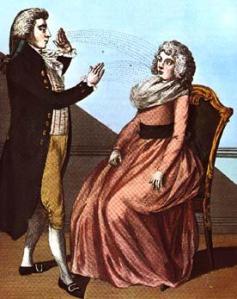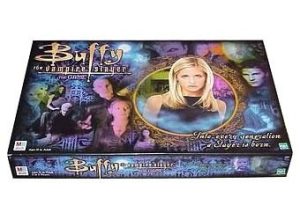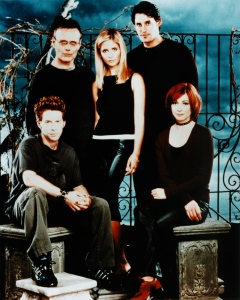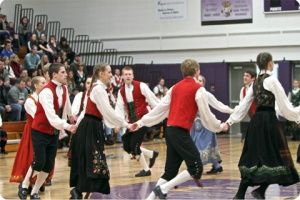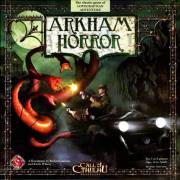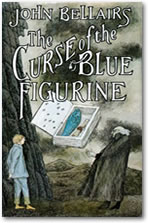We have a therapist character in the Munchen show. His name is Dr. Runnels and he practices decidedly… outdated therapy methods.
In fact, he is a mesmerist.
Mesmerism was a method of psychological and physical healing developed by Franz Anton Mesmer (1734-1815), a Viennese doctor. Only Mesmer didn’t call his technique mesmerism. He called it animal magnetism. Which had nothing to do with our present understanding of that term meaning “sex appeal.”
No, to Mesmer, animal magnetism referred to an invisible fluid that circulated through the universe and in and out of people. Disturbances in the fluid’s flow led to physical and psychological unrest.
To restore proper flow, Mesmer would have patients sit across from him, their knees touching his. He’d move his hands over parts of their bodies, including such sensitive regions as the diaphragm, in sessions that sometimes lasted hours. (Unsurprisingly, this led to at least one scandal: He was accused of having sexual relations with a young female patient he was treating for blindness.)
The goal of Mesmer’s sessions was to produce a “crisis” — a physical convulsion believed to lead to an emotional or physical breakthrough. In this way, it harkens back to the practice of exorcism, which Mesmer had studied early in his life. At the end of a session, to relax the patient, Mesmer would play a little tune the glass armonica — a fascinating instrument about which I’ll blog later.
Mesmerism produced a trance-like state in the patient, but it was different from hypnosis in that the sessions were mostly non-verbal. Still, it is understood as a precursor to contemporary hypnosis in that it lured patients into precognitive states. It also has clear connections to such practices as reiki and energy healing, which are now experiencing a boom in popularity in the West.
A commission including Benjamin Franklin studied mesmerism and animal magnetism for several years. The commission debunked the techniques as being based on nothing more than the power of suggestion. But mesmerism remained popular until the tail-end of the 19th century, when Sigmund Freud’s “talking cure” (aka psychoanalysis) revolutionized treatment of the emotionally disturbed.
The tail-end of the 19th century, by the way, was the real watershed moment in modern psychology because it’s when Sigmund Freud developed his revolutionary “talking cure” (aka psychoanalysis), from which derive most current non-medical forms of psychological treatment.
All this got me thinking about other pre-Freudian psychological belief systems. Here’s are three others. Are we missing any? Let us know in the comments!
Phrenology. Famous from the scads of illustrations available in antique shops, phrenology alleged that the shape of human skulls reflected the shape of people’s brains — and therefore revealed their personalities. There was no associated therapy (haha, skull reshapers), but it was wildly popular as a means of gaining self-insight. Some people even consulted phrenologists about the compatibility of prospective spouses or employees. (Bonus: The device in the video below was made in Wisconsin — not too far from Munchen!)
Physiognomy. Similar to phrenology, this was the idea that face shapes revealed personality traits. It dates back as far as Chaucer, who calls it “fisnamy” in The Canterbury Tales. It experienced a brief revival of attention a few years back, when several studies found that people could identify the faces of gay men in randomly selected photographs. Here’s a decidedly Midwestern-flavored talk show about physiognomy, even though it’s from the Bay Area:
Spiritualism. Perhaps the defining proto-pscyhotherapy of the late 19th century was spiritualism, in which the living communicated with the dead. It’s still popular today, as evidenced by the Lily Dale community of spirit mediums in western New York and the popularity of such traveling psychics as John Holland.

